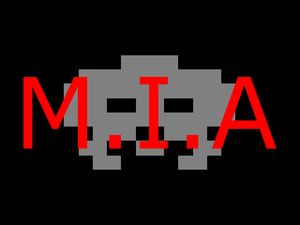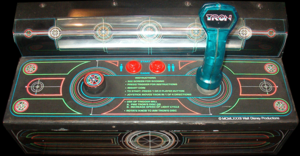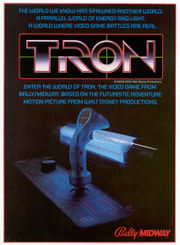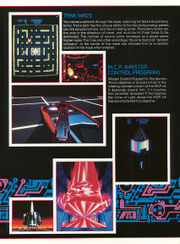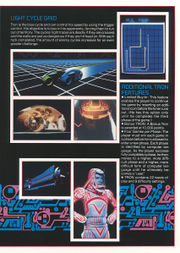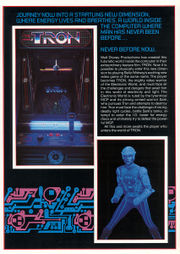Lost In Translation/Tron (arcade)
| Tron | |
|---|---|
| Manufacturer | Bally Midway |
| Released | 1982 |
| Control Method |
8-way Joystick Dial 1 Button(s) |
| Main CPU | Z80 (@ 2.496 MHz) Z80 (@ 2.000 MHz) |
| Sound CPU | Stereo (2x) AY-3-8910A (@ 2.000 MHz) |
| Video Details |
Raster (Vertical) 512 x 480 pixels 30.00 Hz 64 Palette colours |
| Screens | 1 |
| ROM Info | 16 ROMs 110,624 bytes (108.03 KiB) |
| MAME ID | tron · tron2 · tron3 · tron4 |
About The Game
Tron is a 1- or a 2-player arcade video game based on the film of the same name.
When playing this game, Tron is under your control. You make him move back and forth across the screen to confront his opponents, alien and otherwise. The methods he uses to eliminate these opponents depend on which phase of the rack he is in.
The game is displayed in racks; each of which has four completely separate phases. By using the control stick, the contestant(s) can determine which of the four phases he will send Tron into. Once Tron has entered and completed a phase of any particular rack, that phase will not be available again until all of the other remaining phases in that rack have been completed. If Tron is eliminated in any particular phase, the next Tron is allowed to re-enter that phase to play it over again if you want him to.
Game-Play Overview
The 4 phases that make up each rack are as follows :
Phase 1 - Tanks
You are provided with a top view of a maze with your Tank and enemy Tanks in it. The higher the number of the rack you are in, the greater the number of enemy Tanks in there with you. This phase ends when all the enemy Tanks are destroyed - or - when you are.
Phase 2 - Grid Bugs
A side view of a vertical grid is presented to the player in this phase. The Grid Bugs (which look something like spiders) begin to appear and start multiplying immediately. At the same time they are also coming after you. Shoot as many of these as you can while working your way to the I/O Tower (Input/Output Tower) in the centre of the screen. Once you enter this I/0 Tower, this phase is over.
Phase 3 - Cycles
In this phase you have a top view of Cyclists. The higher the number of the rack you are in, the greater the number of enemy Cyclists in there with you. You cannot run into any walls, cross your own light trail or cross the enemy Cyclist's trail. If you do, you will be destroyed. You must box in the enemy Cyclists, forcing them to run into either their own light trail, your light trail, or a wall, destroying themselves.
Phase 4 - MCP Blocks
Here there is a rotating cylinder composed of coloured blocks that is constantly descending on you. The higher the number of the rack you are in, the greater the speed with which the cylinder descends. You must either shoot all the blocks out of the descending cylinder or clear a space so you can enter the cone shaped area at its top. When you do either of these, this phase ends.
Bonus Trons are awarded to you periodically throughout the game as you reach or pass certain preselected point values. Each item that can be shot has an assigned point value.
The object of the game is to have fun while constantly increasing your skill as you play, wiping out as many of the enemy as possible each time to get the highest score.
Tron is made up of racks, each rack contains the 4 games listed above. There are 12 racks in all and the name of each is spelled out at the bottom centre of the monitor screen when you are in it. (See trivia section below)
You must successfully complete each of the separate games that make up a particular rack before you can be advanced to the next rack which will consist of the same 4 games - but they will be harder to complete successfully.
Game selection is random. For instance, if you always pull back on the joystick when you enter a new rack, you will not always get the same game. One time it could be Tank's, the next it might be Grid Bugs, and so on.
Trivia
Released in May 1982.
When Bally/Midway signed a deal to create a Tron video game, they were very pressed for time and needed a game quickly. They decided to let all three of their design teams (their in-house team, Dave Nutting Associates, and Arcade Engineering) take a crack at a prototype. The Dave Nutting Associates team (led by Dave Armstrong) proposed a 3-D colour vector game that was deemed too complex and expensive, thought it was later developed into a prototype called "Earth, Friend, Mission". The internal team eventually won the right to produce the game. The initial design document called for six different mini-games :
- Rings (a light-disc duel between Tron and Sark).
- Paranoia (in which the player builds a bridge of spiders to reach an island).
- Tank Pursuit
- Space Spores
- I/O Tower (the player tries to reach an energy socket while avoiding electrifying blue warriors)
- Light Cycles.
Fearing that they would never get the game out in time, the Rings game was made into a separate game and the Paranoia and I/O Tower game was dropped (though the MCP Cone sequence was later added). At one point the film included deadly spores that were included in the game's Grid-Spider sequence, but when they were removed from the film, they had to be removed from the game as well.
To promote the game, Bally/Midway and Alladin's Castle sponsored a seven-week-long tournament at over 400 locations throughout the coutnry, as well as a celebrity tournament.
Level Names
Most of the levels correspond to a computer language. Of course, some literary license was used for the level names and a couple of them don't really make sense. Anyway, here are the 12 level names (from the easiest to the hardest, respectively) and what they really are:
- RPG: Report Program Generator. Use for generating reports. Usually used with COBOL.
- COBOL: Common Business Oriented Language. Used primarily for accounting. Very old language.
- BASIC: Beginners All-purpose Symbolic Instruction Code. Used primarily for teaching rudimentary programming.
- FORTRAN: Formula Translator. Used for processing numbers and/or formulas.
- SNOBOL: Used for character string manipulation.
- PL1: A play on the actual language called PLI. Language used for solving mathematical problems.
- PASCAL: Teaching language for compiled languages. Not very powerful.
- ALGOL: Algorithmic Language. Influenced the development of more modern language (along with FORTRAN and LISP). Used for number crunching.
- ASSEMBLY: Machine language. Used to write code directly to the computer without having to compile or interpret it.
- OS: Precursor language to OS2.
- JCL: Job Control Language. Used on IBM mainframes to execute specific jobs and scripts on the Job Entry Subsystem.
- USER
Walt Disney Productions sued Williams Electronics for copyright and patent infringement over Williams' use of the name 'tron' in their arcade legend, "Robotron - 2084". Common sense prevailed, however, and Williams won the suit.
The game's sequel, "Discs of Tron" was originally intended to be a part of the original game but tight time constraints meant that the mini-game was not completed in time.
A Tron unit appears in the 1983 movie, 'WarGames', in the 1986 movie 'The Color of Money' and in the 1987 movie, 'Death Wish 4 - The Crackdown'.
Two Tron machines were shown at the 2003 classic arcade games show 'California Extreme' in San Jose, California.
Updates
- OLDER VERSION (set 4 in Mame)
- Level 1 (RPG) gives you 1,000 on the timer instead of 500 in the I/O Tower game, making it easier to get the 1,000 point bonus for killing all grid bugs in level 1.
- The series of sounds that play when blocks are destroyed in the MCP Cone game are higher in pitch than in the other revisions of Tron.
- Each level features different pattern schemes from the other revisions - Play level 2 (COBOL) in Set 1, 2, or 3 and then play level 2 in Set 4, keeping the Game Difficulty setting at the default (5) each time, and you'll see what we mean.
Scoring
Scoring in this game is relatively easy since there aren't a lot of enemies to keep track of.
| Target | Points |
|---|---|
| Grid Bugs | 50 |
| Bit | 5,000 |
| Blocks | 25 |
| Light Cycles | 500 |
| Tank - 1st Hit | 100 |
| Tank - 2nd Hit | 300 |
| Tank - 3rd Hit | 500 |
You get a 1,000 point bonus for destroying all the Grid Bugs.
You get the remaining time added to your score when you enter the I/O Tower.
NOTE : On Level 1 (RPG), you only get 500 on the timer. On all other levels, you get 1000 on the timer. EXCEPTION : In older version of Tron (set 4 in Mame), you always get 1000 on the timer, even on Level 1.
You get a 1,000 point bonus for destroying all the Blocks.
Tips and tricks
When you start the game, you will have a cursor in the middle of a computer-looking grid. You have eight seconds to go one of four directions on that grid. If you don't, you will be randomly sent in a direction. Once you have completed an area, you can no longer go to that area until you get to the next level. The areas are randomized on this computer grid so you won't know what you will get next. Below are the four areas and strategies to get through them.
I/O Tower
This is one of the easier areas to get through. It just involves a lot of shooting.
- Quickly establish where the Grid Bugs are. That way you can quickly aim to clear out a path if necessary.
- The game simulation sailer comes out at random times and drops the Bit off. Do everything you can to get to it for a free 5,000 points.
- Work your way to one of the exits and 'camp out'. Just use the spinner to aim high and low to take care of the Grid Bugs. Once the timer hits 100, go ahead and exit the screen.
- It is possible to get over 10,000 points in this area alone (5,000 for the Bit and over 5,000 for Grid Bugs killed).
- On the earlier levels, try to take out all of the Grid Bugs for the 1,000 point bonus.
Light Cycles
This is one of the harder areas until you learn the patterns. Then it will become a breeze.
- The arena for this game is a 9 x 9 grid. Use the grid lines to gauge distances and to also know where the turns are.
- Hitting the wall, your light trail, or an enemy light trail will end your cycling career very quickly.
- Depending on the machine set up, you will need to identify different patterns and make the appropriate adjustments to your strategy. Make sure you are staying at full speed until the enemy light cycles are trapped.
- Usually you can adjust when you see enemy cycles coming after you. A lot of times they will follow another cycle into the wall or a light trail. The enemy cycles become much quicker after level 10.
- If the three light cycles are coming straight down, go right and up around them. Then do a rectangle pattern leaving an opening to the right side to allow the enemy cycles to crash against the wall.
- Use the above pattern if the middle or right cycles go straight (the other ones will veer around before they head down).
- For any other occasion, it's best to go left and make a box that way. Again, the enemy cycles will destroy themselves before you get into trouble.
MCP Cone
Another easier area. Even if you mess up a little, you can still recover from your mistake.
- First, determine the cone's speed and direction of travel. You can accomplish the second thing by shooting at it to determine which way the hole travels.
- Next, determine your speed. This will determine how much time you have to blow through the cone to get to the exit.
- Once you have determined the above, go over to the side that the cone is entering from. For example, if the cone is moving from left to right, the go over to the left side and start shooting.
- The four block cones are pretty easy. Just rapidly blast a path and go up.
- The six block cones are a little trickier. You will need to open up the bottom part of the cone. Enter this new opening and start to chew at the top. You will end up having blocks rotate below you as you head up. Be careful and watch around you since you will end up surrounded by blocks before you enter the exit.
- The hardest cone to get through is when Tron is travelling fast and the cone is moving slow. You have to quickly blast a path any way you can or you will collide with the cone.
- For extra points, you can position yourself half-way out of the exit and blast at the top blocks. On the earlier levels, try to get the 1,000 point bonus.
Tanks
Probably the hardest area of the game. You have to learn how to move and shoot (in different directions) at the same time.
- It takes three hits to destroy an enemy tank. You have the advantage, though, by being able to use rapid fire and bouncing your shots off the walls. Enemy tanks can only have one shot out a time.
- This rebounding of shots can be a very effective offensive measure. You may be able to hit tanks from afar or hit them around corners just by rebounding your shots just right. Prevent them from getting close.
- The pink teleporter area is the key to surviving many of the tank patterns. Just don't go too far in or you may end up teleporting to a hostile environment very quickly.
- If you stay off the tank trails, enemy tanks will not fire on you. They can, however, ram your tank (this is especially true if you are hanging out in the teleportation area).
- Like other parts of Tron, there are patterns you can use on the specific tank patterns to ensure your survival.
Bugs
- This is an interesting bug. On the MCP Cone levels, if you go all the way to the right or the left and keep moving, you can move the whole playfield to the side. This doesn't seem to have any other affect.
- Here's an odd Tron bug : On the Recognizer Tank levels, make your way to one of the little alcoves in either the top right, or bottom left corners. The tanks cannot shoot, and will not go down an alcove, so therefore cannot kill you. Then, wait approximately 9 to 10 minutes without moving your tank. You can fire, but do not kill all the recognizers. After the time (9-10 mins), the sound system will go berzerk, starting with a very high pitch tone, which falls to a low tone that vibrates the cabinet. The sound also goes berzerk if you enter the tower at 0099 units on the bug screen.
Series
- Tron (1982)
- Discs of Tron [Upright model] (1983)
- Discs of Tron [Environmental model] (1983)
Staff
- VP Engineering
- John Pasierb (JP)
- Software
- Bill Adams (BA)
- Hardware
- Atish Ghosh (AG)
- Art / Cabinet Designer
- George Gomez (CG)
- With Support From
- Tom Leon (TL)
Cabinet and Artwork
Ports
- Consoles
- Nintendo Game Boy Advance (2004, "Tron 2.0 - Killer App")
- Computers
- Tandy Color Computer (1983, "Kron")
- Oric I (1984, "Light Cycle")
- Sinclair ZX Spectrum (1984, "Light Cycle")
- Others
- LCD handheld game (1982) released by Tomy
Soundtrack Releases
| Album Name | Catalogue No. | Released | Publisher | Comments |
|---|---|---|---|---|
| Electroid : Rebuilt | N/A[1] | 2005-01-01 | N/A | CD version. |
| Arcade Ambiance 1983 | N/A[2] | 2003-01-01 | Andy Hofle | Digital download only. |
References
- ↑ Electroid : Rebuilt (CD) at the VGMdb
- ↑ Arcade Ambiance 1983 (Digital Download) at the VGMdb



